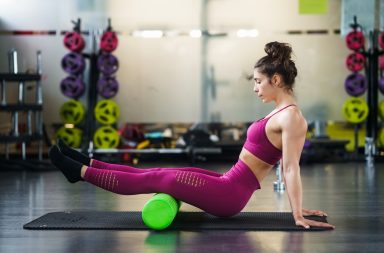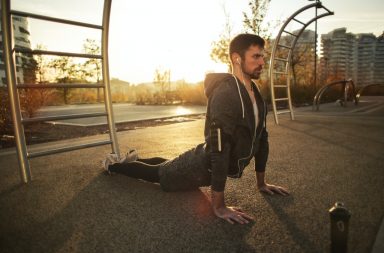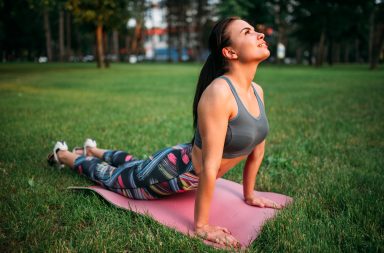If you’re into your working out, you understand the benefits of stretching before and after exercise. But so often we overlook how we can improve this practice for faster recovery and better comfort. A foam roller is an undervalued pieces of equipment to aid stretching whilst massaging the muscles. Foam roller exercises for the low back and hips have the potential to change your life no end!
Yes, stretching after exercise is great for fending off injury or tightness. However, what is so often overlooked is the benefit of stretching as a daily routine—even if general exercise isn’t your thing! We all use our bodies constantly, all day, without working up a sweat. Even in sleep we move around at least a little, so it’s always worth showing our muscles the love they deserve.
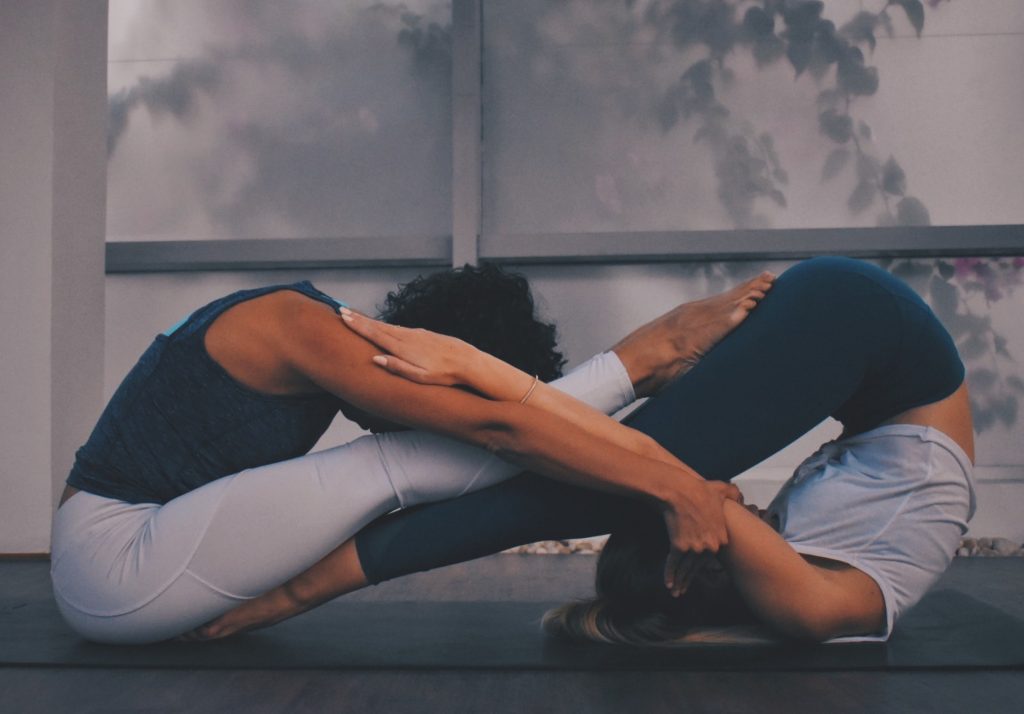
Photo by Rawan Yasser on Unsplash
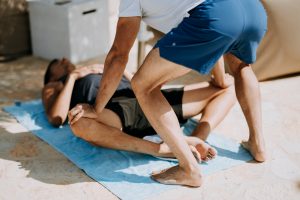
Photo by Annie Spratt on Unsplash
Walking, climbing stairs, dancing: Every move has the potential to cause us some damage if we don’t look after those muscles and joints. Studies have also shown that a sedentary lifestyle can cause muscular and skeletal issues, causing long term and often chronic pain.
There can be no doubt: Bodies, and minds, require care and consideration.
And this is where the underrated foam roller comes in! General stretches, such as those dynamic poses before and static stretches after exercise (as is the consensus), are great. But, when it comes to getting deep into muscle tissue, a little help goes a long way.
If you are suffering from lower back and hip pain, there are many foam roller exercises you can use to give you a new lease on life. We’ve put together a list of the 7 most beneficial foam roller exercises for your lower back and hips.
And the best part is, you can do these whilst watching TV, listening to the radio or just chatting to a friend on the phone!
Before we jump in, lets answer the question on your lips:
How Can A Simple Foam Roller Help My Muscles?
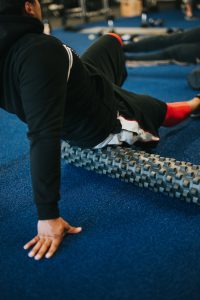
Photo by Andrew “Donovan” Valdivia on Unsplash
When looking at the makeup of a muscle, you see a system of skeletal muscle tissues, tendons, blood vessels and nerves. These are responsible for moving the skeletal system, doing lots of work on any given day.
Through exertion or lack of movement, adhesions can form within the muscle. This is where the fascia—which sits on top holding the muscle together—sticks to the fibres and tendons, becoming tight and sore.
Using a foam roller to get into those tight spots helps to breaks down those adhesions. This allows fresh blood and oxygen to flow into those areas. Reducing recovery time after exercise, and fending off potential injury as the muscles and tendons stretch and relax: These are just two of the benefits of foam roller exercises for the lower back and hips! Take a look at the exercises below, and you’ll see many more.
Now, lets get into the poses!
Top 7 Foam Roller Exercises for Lower Back & Hips
The best thing about these exercises is that they can be done in a matter of minutes. Even better, as the muscles of the back and hips are all connected, any of these exercises will help with problems you might have in these areas.
An important pointer is to maintain a good posture throughout the poses. Shoulders back and blades moving gently towards the hips. When supporting weight on the arms, don’t lock out the elbows as this can cause strain. Take regular breaks when rolling out muscles, and keep a slight bend in the elbow as much as possible. Your foundation within these foam roller exercises for lower back and hips create a great basis for your posture in general!
Hamstrings
 The Move: On a mat or carpeted floor, sit with the foam roller under one thigh, just below the glute (the butt muscle). Hands rest on the floor behind you to support weight. Lift off hips and roll down toward the knee, before returning to the top of the thigh. Repeat as necessary, holding in an area of tension for 30 seconds or more to allow the roller to get deeper into the area. If direct pressure is too much, hold close to the tight spot and oscillate the thigh left to right slowly. This allows for lateral movement across the muscle, releasing tension further.
The Move: On a mat or carpeted floor, sit with the foam roller under one thigh, just below the glute (the butt muscle). Hands rest on the floor behind you to support weight. Lift off hips and roll down toward the knee, before returning to the top of the thigh. Repeat as necessary, holding in an area of tension for 30 seconds or more to allow the roller to get deeper into the area. If direct pressure is too much, hold close to the tight spot and oscillate the thigh left to right slowly. This allows for lateral movement across the muscle, releasing tension further.
Whilst performing this exercise, the other foot can be placed on the floor in front of the roller for extra weight support. Alternatively, for added muscular pressure, cross it overtop of the other.
Benefits: Not only does this improve range of movement in the upper leg, but the three hamstring muscles are connected to the pelvis. This means you are also decreasing stress on the hips and lower back!
Quads
 The Move: Lay on your front, with the foam roller positioned under the top of the thigh, just below the hip. Forearms and elbows are on the floor supporting weight, with the other leg cocked out to the side, knee resting on the floor. Roll down toward the knee and back up to the hip. Repeat as necessary, holding for 30+ seconds in areas of tension.
The Move: Lay on your front, with the foam roller positioned under the top of the thigh, just below the hip. Forearms and elbows are on the floor supporting weight, with the other leg cocked out to the side, knee resting on the floor. Roll down toward the knee and back up to the hip. Repeat as necessary, holding for 30+ seconds in areas of tension.
When holding in a tight area you can also bend and flex the knee, aiding muscle release.
Benefits: There are four quadriceps muscles, connecting to the kneecap and pelvis. Tight quads can create issues with tight hips and knee pain, so this move has fantastic benefits for both.
IT Band
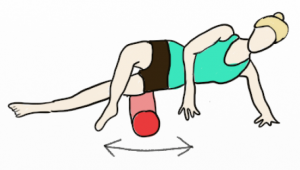 The Move: With the foam roller laying across the width of the mat or floor, lay on your side (as though in side plank) with one thigh resting on the roller. With the elbow and forearm placed on the floor in front of the roller for support, gently roll down toward the knee, and back up. Repeat as necessary, moving laterally forwards and backwards to get into areas of tension, holding for 30 seconds or more.
The Move: With the foam roller laying across the width of the mat or floor, lay on your side (as though in side plank) with one thigh resting on the roller. With the elbow and forearm placed on the floor in front of the roller for support, gently roll down toward the knee, and back up. Repeat as necessary, moving laterally forwards and backwards to get into areas of tension, holding for 30 seconds or more.
An additional exercise you can do in this area is to use a tennis ball or similar to get into the fascia at the hip and just above the knee. Simply lay on your side with the ball directly under the fleshy part of the hip and roll the ball in small circles around the area for up to 1 minute. Repeat this at the low thigh, just above the outside of the knee.
Benefits: The IT band is a long thick section of fascia similar to a tendon that runs from the top of the pelvis, down to the knee and shin. It is responsible for keeping legs and hips stable, so can be very tight. Especially in runner’s legs! The fascia cannot be stretched as such, but foam rolling can help facilitate release, creating greater mobility throughout the legs and lower back.
Adductors (Inner Thigh)
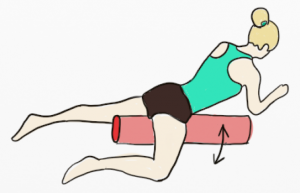 The Move: With the roller parallel to the body at hip height on one side, lay face down on the mat or floor. With a bent knee, place the top inner thigh on the roller, slowly moving toward the inner knee. Repeat as necessary, holding in tight spots for, you guessed it, 30 seconds or more!
The Move: With the roller parallel to the body at hip height on one side, lay face down on the mat or floor. With a bent knee, place the top inner thigh on the roller, slowly moving toward the inner knee. Repeat as necessary, holding in tight spots for, you guessed it, 30 seconds or more!
Whilst performing this exercise, the alternate leg should be stretched out along the floor, the knee on the floor for extra support. To support the lower back, focus on elongating your spine, relaxing the tailbone towards the heels.
Benefits: This relieves tension in the adductor muscles, and gives 360 degree relief to the whole leg above the knee when done alongside hamstring, quad and IT band exercises. This improves leg mobility and relieves pressure in hips and lower back. It also has the added benefit of strengthening the back muscles when the posture is observed correctly as above, as the core muscles turn on. What is not to love!
Glutes
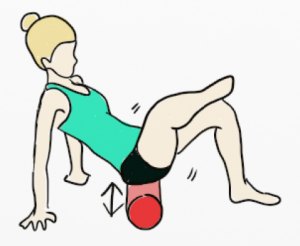 The Move: Sit on the foam roller, resting the left glute down. Bend the left knee and place the left ankle on the right knee. Roll back and forth, oscillating side to side over when holding in areas of tightness or tension.
The Move: Sit on the foam roller, resting the left glute down. Bend the left knee and place the left ankle on the right knee. Roll back and forth, oscillating side to side over when holding in areas of tightness or tension.
Benefits: As a muscle, the glutes are hard to get to when stretching regularly. This is one foam rolling exercise that will often feel really lovely to do, and can release tension in the hips and lower back when done regularly.
Low Back
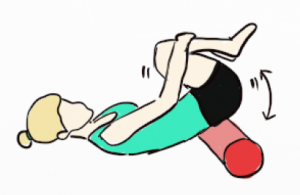 The Move: Lay on your back, shoulders and top of your spine on the floor with the foam roller resting underneath the sacrum. This is the hard bone of the pelvis, just below the natural curve of your spine, where the roller should be placed. Start with knees bent, feet flat on the floor. When you feel secure on the foam roller, lift the knees and pull them towards your chest using hands on the backs of thighs or on the shins for added strength. Rock slowly, moving side to side for up to one minute. Repeat 2-3 times.
The Move: Lay on your back, shoulders and top of your spine on the floor with the foam roller resting underneath the sacrum. This is the hard bone of the pelvis, just below the natural curve of your spine, where the roller should be placed. Start with knees bent, feet flat on the floor. When you feel secure on the foam roller, lift the knees and pull them towards your chest using hands on the backs of thighs or on the shins for added strength. Rock slowly, moving side to side for up to one minute. Repeat 2-3 times.
Benefits: This is a great one to do if you have lower back tension from sitting in a chair all day, or if you do high impact activities like running. The lift of the roller allows your hips, spine and the surrounding muscles to relax down, increasing all round mobility in the region when done regularly.
Hip Flexors
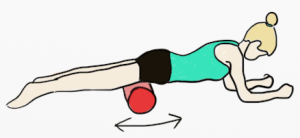 The Move: Facing down toward the floor, rest on top of the roller across the width of your pelvis. Roll to one side slightly, putting more pressure on one hip. The feet should be extending back behind you, knees lifted. In this position, roll up and down an inch or two. Do this for 1-2 minutes, repeating on each side.
The Move: Facing down toward the floor, rest on top of the roller across the width of your pelvis. Roll to one side slightly, putting more pressure on one hip. The feet should be extending back behind you, knees lifted. In this position, roll up and down an inch or two. Do this for 1-2 minutes, repeating on each side.
Benefits: There are several muscles here, connecting the lower body to the upper body. You might sometimes see someone at the gym rolling out their lower back with a foam roller. This isn’t advisable, and often leads spine and nerves pinching. This can also be caused by a lot of time spent sitting. This exercise offers some relief in both the hip flexors and the lower back, as they are connected to the lumbar spine. Releasing hip flexors releases the lower back, increasing range of motion and often reducing pain.
So often, we do not realise the relevance of stretching out and massaging the muscles until it is too late and pain sets in. As anyone who has experienced bodily pain will agree, it is not something you want to have to deal with. Better then to adopt a pre-emptive regime of exercise and firm but rewarding stretches that will help you live life to the fullest!
When incorporating these foam roller exercises for lower back and hips into your daily or weekly routine, you’ll start to see improvements in your range of movement. We also have some pro tips for rolling out your calves, helping to care for the whole lower body.
Take care of your calves with your foam roller
The body is a vast system of interconnected nerves, tissues, tendons and joints that hold us up, helping us move. The low back, hips and legs are our grounding force. Taking care of these will pay dividends in the future.
There are a number of foam rollers out there, but its best to start with a traditional smooth, medium firm roller if new to the party. Foam rolling does come with a warning, however. It can often be very uncomfortable when getting into those problem areas. Often, if your muscles aren’t used to the pressure, they can complain quite loudly. Start off gentle and slow, working up to harder, ridged rollers for deeper muscular massage.
The discomfort should generally feel like an ache in the focus area. If you feel sharp pain at all, it is advised to stop immediately. It is always advisable to seek advice from a medical health practitioner before embarking on any new fitness or stretching regime
Doing a little to relieve those tendons and stretch those muscles will spur you on to do more. Or if you are a regular exercise fanatic, you will see how rolling out muscles in your legs and back can increase your potential within workouts, and even reduce recovery time!
Now you have the know how to relieve your muscles, heres a guide on some exercises to start your work out.
Body weight exercises to do at home and protect your knees
